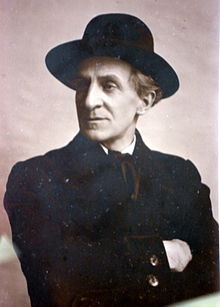Alfred East
Alfred Ost (born February 14, 1884 in Zwijndrecht , † October 9, 1945 in Antwerp ) was a Belgian painter, draftsman, illustrator, lithographer and poster artist.
His father, a coal trader, came from Mechelen , his mother from Rupelmonde . He was the fourth in a family with five children, including Urbain Ost, who was to become Attorney General, and his younger brother, Hector, who was to become a priest.
At the age of 18, against the advice of his father, he attended the Koninklijke Academie voor Schone Kunsten van Antwerpen , where he won the first drawing award. He especially studied animal painting with Frans Van Leemputten .
Between 1907 and 1911 he was commissioned by the Antwerp Zoo to draw animals, plants, flowers and decorative elements in one of the zoo's buildings, the Egyptian temple.
In 1908 he was entrusted with the creation of several advertising posters, especially for a brewery in Willebroek.
The family moved to Brussels again in 1911. In the capital, Alfred Ost produced a series of lithographic posters on behalf of the Théâtre de la Monnaie and several Flemish associations in Brussels
In 1913 he had his first major exhibition in the Boute gallery in Brussels, and in 1914 a second major exhibition in Antwerp in the Memlinc room with 202 exhibits. This earned him several orders for posters in Brussels, including for the Théâtre de la Monnaie and a poster to promote tourism.
When the First World War broke out, Alfred Ost wanted to volunteer, but was refused. On October 7th (Antwerp was to fall into German hands on October 10th), he went into exile in the Netherlands, accompanied by his parents and sister, and settled in Sluis .
At the risk of running out of money, Alfred Ost decided to go to Amsterdam, where, as he expected, he could make a living as an artist. The family moved to Amsterdam at the beginning of 1915 and stayed there until the spring of 1919. Shortly after his arrival, he contacted the art printer and owner of a printing company Jan Kotting,
In 1919 he returned to Belgium and settled in Borgerhout, a suburb on the eastern outskirts of Antwerp, where his brother Hector was pastor in the parish of Sainte-Famille. In 1919 and several times thereafter, he applied for the post of teacher at the Antwerp Academy of Fine Arts, but was not accepted. He was appointed teacher of drawing in primary school in 1921 and worked at a school in Antwerp (1921–1938), then in Borgerhout (1929–1943).
The project he had in the late 1920s to found his own East Museum to bring together his best works failed. The lack of official recognition, his numerous misfortunes, his sentimental disappointments and finally his health problems brought him into material trouble and made him a lonely man who became more and more withdrawn in a marginal existence.
If at the beginning of his career he was ready to sell his huge hits, once he had a certain reputation he had concerns about monetizing his production. In 1936 he donated 461 pieces to the city of Mechelen and in 1937 50 pieces to the city of Roosendaal and 80 to the small town of Hoogstraten. An exhibition of his works was organized in Mechelen in 1938.
Even before World War II , his zeal was gradually wiped out, and at the same time his health deteriorated. In 1940 he held an exhibition at the Antwerp Zoo.
During the war he exchanged his ration cards for board and lodging at the Jesuit college in Borgerhout. From June 1941 to January 1944, as a thank you, he drew with charcoal on the white walls of the corridors of the college, large compositions with religious themes and popular and rural motifs: angels, saints, scenes from the Gospel, episodes from the life of St. Francis Xavier, Missionary work, horse riders, a popular homage to the Blessed Virgin, Joan of Arc, etc. East also adorned a corridor of the Collège Saint-Michel in Brasschaat-Vriesdonk in the extreme northern suburb of Antwerp.
When Antwerp was targeted by air raids in late 1944, he stayed with the Salesian Fathers in Grand-Bigard near Brussels. He had one last exhibition in the Antwerp Zoo in 1945. He died a few months after the war ended.
literature
- Ost, Alfred in: Dictionnaire des peintres belges (online)
Web links
- Alfred East. Biographical data and works in the Netherlands Institute for Art History (Dutch)
| personal data | |
|---|---|
| SURNAME | East, Alfred |
| BRIEF DESCRIPTION | Belgian painter, draftsman, illustrator, lithographer and poster artist |
| DATE OF BIRTH | February 14, 1884 |
| PLACE OF BIRTH | Zwijndrecht |
| DATE OF DEATH | October 9, 1945 |
| Place of death | Antwerp |


